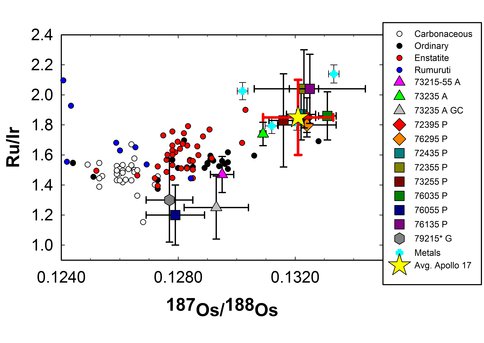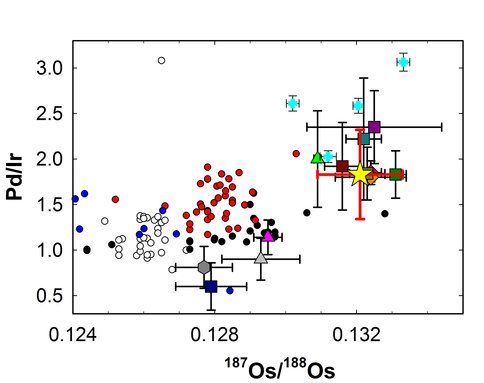2013 Annual Science Report
 NASA Goddard Space Flight Center
Reporting | SEP 2012 – AUG 2013
NASA Goddard Space Flight Center
Reporting | SEP 2012 – AUG 2013
Fingerprinting Late Additions to the Earth and Moon via the Study of Highly Siderophile Elements in Lunar Impact Melt Rocks
Project Summary
We have completed analysis of highly siderophile element (HSE) abundances and Os isotopes in seven Apollo 17 impact melt breccias. The project represents a portion of UMd Ph.D. student Miriam Sharp’s dissertation, and the results of three years of GCA summer internships of Lorne Loudin and Iva Gerasimenko. The resulting large database for impact melt rocks from this site is consistent with a dominant signature imparted to rocks from this site by a single major impactor, most likely the impactor that created the Serenitatis basin. The composition of this impactor was broadly chondritic with respect to HSE, but characteristically enriched in Re, Ru and Pd relative to most chondrites that have been analyzed for these elements. The characteristics of the dominant impactor are most similar to chondritic meteorites that are relatively poor in organics and volatiles. These results suggest that the Serenitatis impactor originated in the inner portion of the present asteroid belt. The formation of this basin was likely not a process that delivered substantial water and/or organics to the lunar crust.
Project Progress
We have now completed the analysis of a suite of seven, diverse Apollo 17 lunar impact melt rocks for highly siderophile element (HSE: Re, Os, Ir, Ru, Pt, and Pd) abundances and Os isotopes (in addition to the three we previously analyzed in Puchtel et al., 2008). Each rock was subdivided into 10 to 15 subsamples for individual analysis, so this project has involved the generation of more than 500 individual elemental and isotopic analyses. The project has comprised a major part of the Ph.D. dissertation of UMd student Miriam Sharp, and also includes data contributed by GCA summer interns Lorne Loudin and Iva Gerasimenko. The overarching purpose of this work has been to fingerprint the HSE characteristics of late heavy bombardment (~4.0 to 3.8 Ga) additions to the Moon, and presumably the Earth. We do this using the relative abundances of the HSE that occur in generally high abundance in likely lunar impactors (e.g., chondritic meteorites), but in extremely low abundance in the indigenous lunar crust. The work on the Apollo 17 suite has been predicated on obtaining data for a sufficient number of samples to make a statistically meaningful assessment of the dominant impactor signature at a single landing site. In addition to characterizing the dominant HSE signature of the impactor(s), another major objective of this work has been to document the level of impactor homogeneity/heterogeneity present at the Apollo 17 site. Finally, this study has constantly sought to test the hypothesis that the impactor HSE fingerprint is recorded with a high degree of fidelity in impact melt rocks, despite the high energy processes that that acted on the rocks during the progression of basin-scale impacts.
Our work on metal globules and granulitic clasts extracted from some melt rocks has shown that the impact process incorporated older impact-derived lithologies (with different siderophile element characteristics), and caused some minor redistributions of siderophile elements within small samples. Despite these complexities, a dominant impact signature has been obtained for the Apollo 17 site. The dominant impactor signature of the Apollo 17 melt rocks is characterized by Os/Ir and Pt/Ir ratios well within the range of chondritic meteorites, but higher averaged 187Os/188Os (a proxy for long-term Re/Os), Ru/Ir and Pd/Ir ratios than most bulk chondrites (Insert Fig. 1a-b). The similarity of HSE characteristics of most of these melt rocks is consistent with the interpretation that most melt rocks at the Apollo 17 site are dominated by a single impactor siderophile element signature. The Apollo 17 landing site is located at the edge of the Serenitatis basin, so the most likely HSE signature present in the melt rocks is from that basin-forming impactor. The characteristics of the dominant impactor are most similar to chondritic meteorites that are relatively poor in organics and volatiles. These results suggest the Serenitatis impactor originated in the inner portion of the present asteroid belt. This impact likely did not deliver substantial water and/or organics to the lunar crust. A manuscript reporting all of these data has been accepted by Geochimica et Cosmochimica Acta (Sharp et al., 2014).
A second project, utilizing the isotopic compositions of Ru and Mo isotopes to document the genetics of objects involved in the late heavy bombardment has advanced during the past year. Chemical separation and mass spectrometric techniques have been refined to measure small nucleosynthetic isotopic heterogeneities that are present in early solar system objects and likely transferred to lunar impact melt rocks. We expect to make the first measurements on lunar samples in 2014.
Publications
-
Sharp, M., Gerasimenko, I., Loudin, L. C., Liu, J., James, O. B., Puchtel, I. S., & Walker, R. J. (2014). Characterization of the dominant impactor signature for Apollo 17 impact melt rocks. Geochimica et Cosmochimica Acta, 131, 62–80. doi:10.1016/j.gca.2014.01.014
-
PROJECT INVESTIGATORS:
-
PROJECT MEMBERS:
Richard Walker
Project Investigator
Miriam Galenas
Collaborator
Igor Puchtel
Collaborator
Emily Worsham
Collaborator
-
RELATED OBJECTIVES:
Objective 1.1
Formation and evolution of habitable planets.

